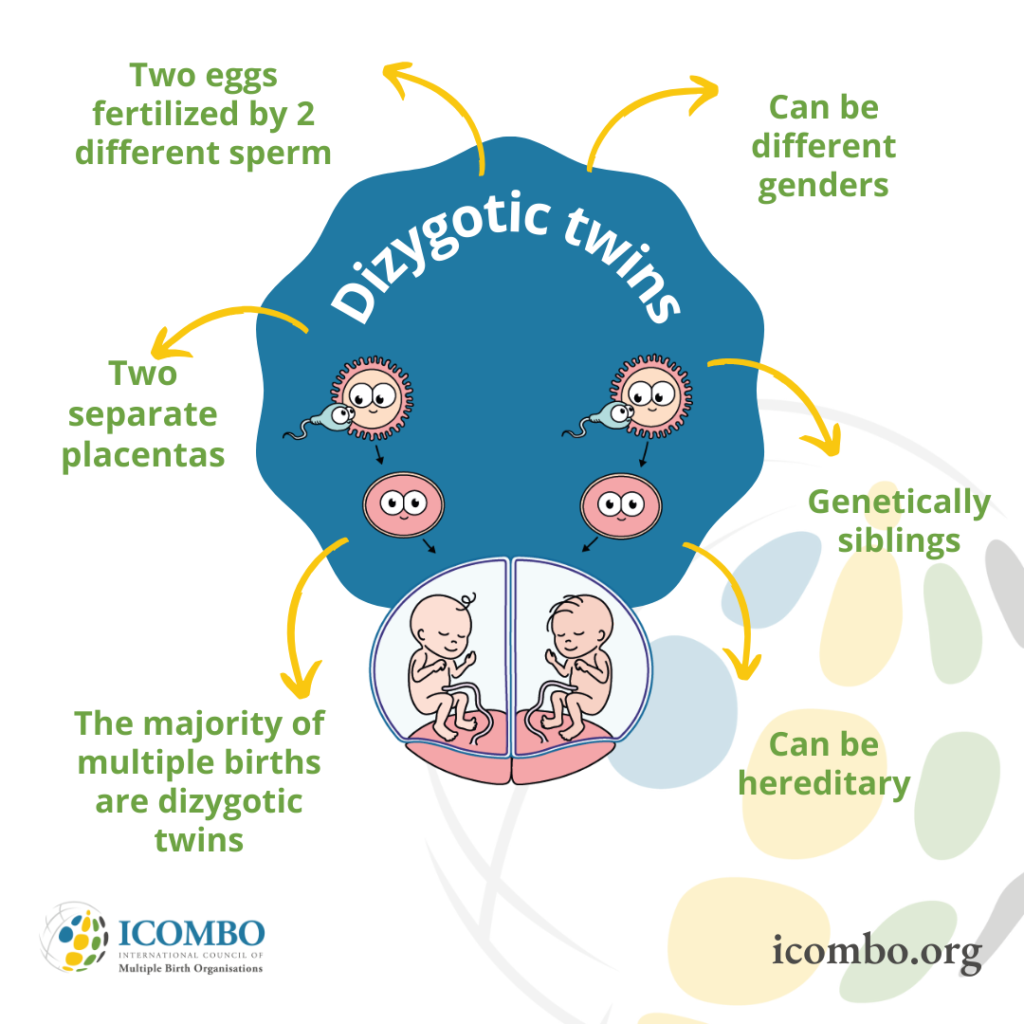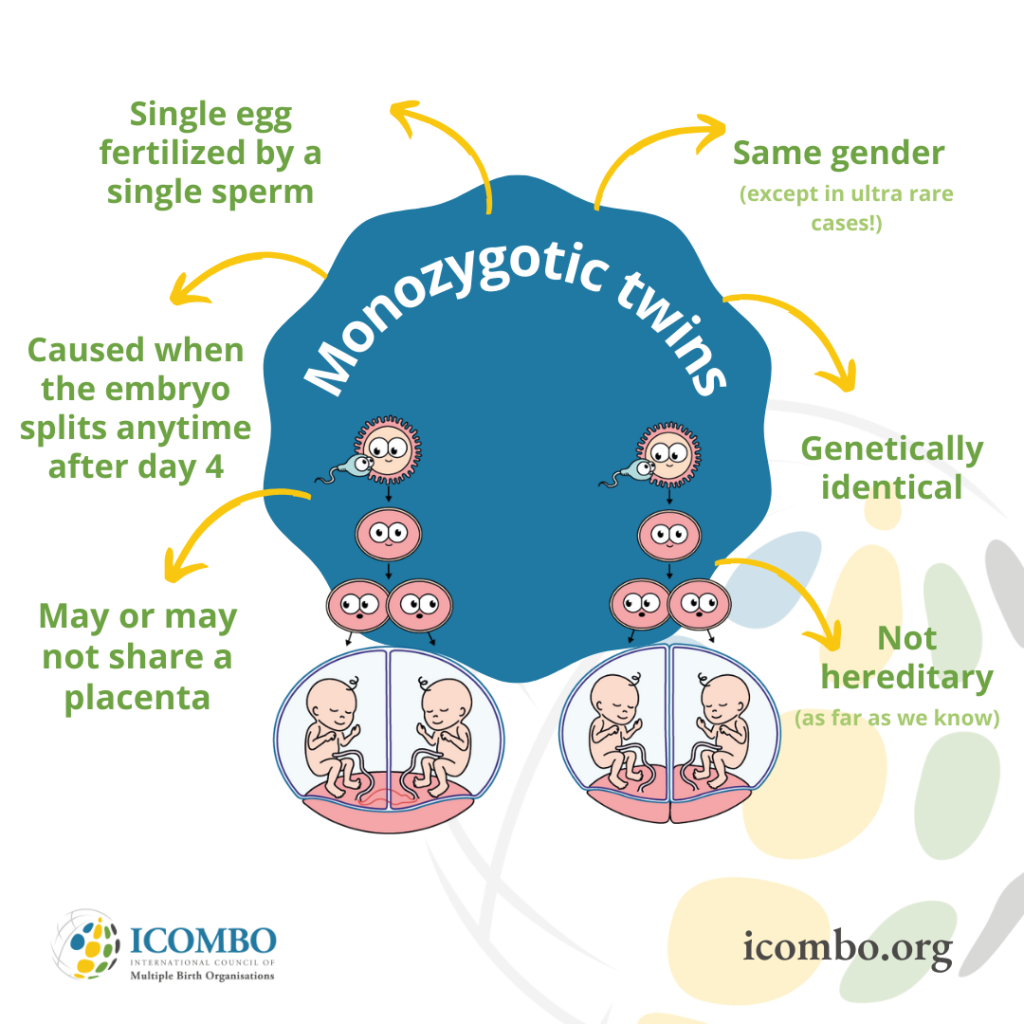Zygosity for twins
For twins, zygosity refers to the degree of genetic similarity within each pair. There are two main types of twins. Dizygotic (di = two, zygote = egg) are commonly referred to as fraternal twins. Monozygotic (mono = one, zygote = egg) are commonly referred to as identical twins.
It is estimated one third of all twins will be identical and two thirds non-identical.
Dizygotic (DZ, fraternal) twins occur when two eggs are released at a single ovulation and are fertilised by two different sperm. These two fertilised eggs then implant independently in the uterus. DZ twins share around 50% of their genes, which is the same type of genetic relationship as non-twin siblings (hence the term fraternal).
- approximately half are the same sex and half are different sex
- each has its own placenta which is continuous with the chorion (outer membrane), with rare exceptions
- each is as genetically similar as any same-sex or different-sex siblings

Monozygotic (MZ, identical) twins develop when one egg is fertilised by a single sperm and during the first two weeks after conception, the developing embryo splits into two. As a result, two genetically identical babies develop.
- approximately one third of MZ twins have separate placentas
- approximately two thirds of MZ twins share a single placenta despite having their own inner sac (amnion), umbilical cord and share of the placental mass
- all MZ twins are the same sex with rare exceptions
- all are genetically identical, or almost 100% identical

Some rarer types of twins
Mirror twins: Also called mirror image twins, they are a subset of identical twins with opposite features, i.e. one will be right-handed and the other will be left-handed, hair will part on opposite sides. Around a quarter of all identical twins may be mirror twins. One mirror twin may have situs inversus. This is where the organs will be on the opposite side of the body, e.g. heart being on the right. This type of twinning is not common.
Half-identical twins (polar body twinning): Polar body twinning is very unusual and very rare. The process is quite complicated. The polar body appears when the egg has been developing, even before fertilisation. It is a small cell that does not function and will usually degenerate and die. It is thought that in some cases, when the egg is old, the splitting off of the polar body takes place in an abnormal way. It then becomes larger, receives more nourishment, and does not die as it usually does. Instead, it acts as a second egg. The polar body and the egg share identical genes from the mother, but they may then be fertilised by two separate sperm cells from the father. This will result in twins who share half their genes in common (from the mother) and the other half different (from the two sperm cells). They share some features of identical twins and some features of fraternal twins and thus are called half-identical twins.
Chimerias (mixed chromosomes): Another form of twinning that has been identified is called chimerism. This is thought to occur if two separate sperm cells fertilise two separate eggs which then fuse, producing individuals with different sets of chromosomes. Some have been identified that have more than one distinct red blood cell type and individuals who are both XX and XY (the sex chromosomes — XX being female and XY being male.) This phenomenon might also be associated with fused placentas, causing intermixing of the circulations. It is very rare, and fewer than 25 cases have been identified. It is more common in other mammals, such as calves.
Boy/girl identical multiples: Though identical twins are thought to be always the same gender, in extremely rare cases boy/girl monozygotic twins are a possibility. This happens when there is a genetic mutation in male babies, one baby loses a Y chromosome which then develops as female. A chromosome disorder known as Turner’s Syndrome would affectthe female; symptoms can include extremely short stature, puberty issues, hearing problems among others.
Superfecundation: Twins can have different fathers. It happens when the mother ovulates more than one egg and has more than one partner during her fertile period. One egg is fertilised with sperm from one partner, and the other egg with sperm from the second partner. These types of twins are always fraternal or dizygotic.
Superfetation: Superfetation occurs when a woman ovulates more than one egg, but the eggs are released at different times, sometimes up to 24 days apart, and they are fertilised when they are released. The resulting twin pregnancy has different conception dates, so the babies may be quite different in size. Days or weeks may separate the births. It is quite an unusual event. In some cases, the births of twins may be weeks or months apart due to deliberate medical intervention. This is called interval birth.
Parasitic twins: This is a very rare event when conjoined twins develop disproportionately with the stronger baby supporting the fetus in fetu. A parasitic twin can consist of extra limbs or abnormal cell growth that grows inside the other stronger twin.